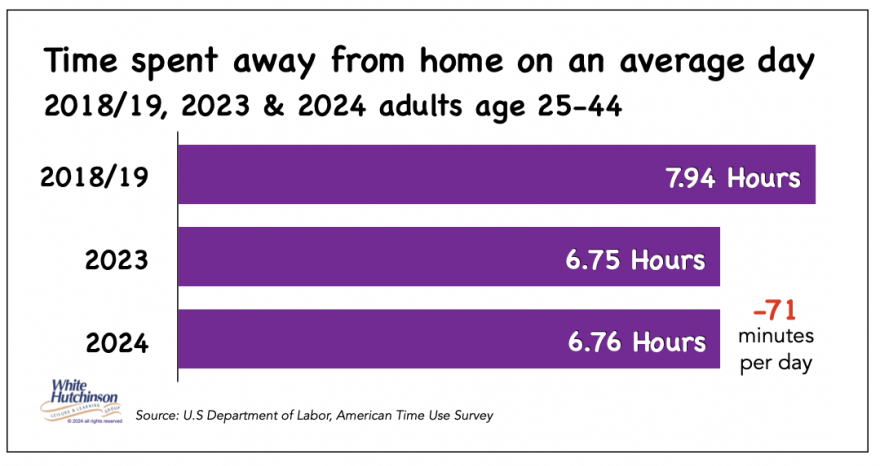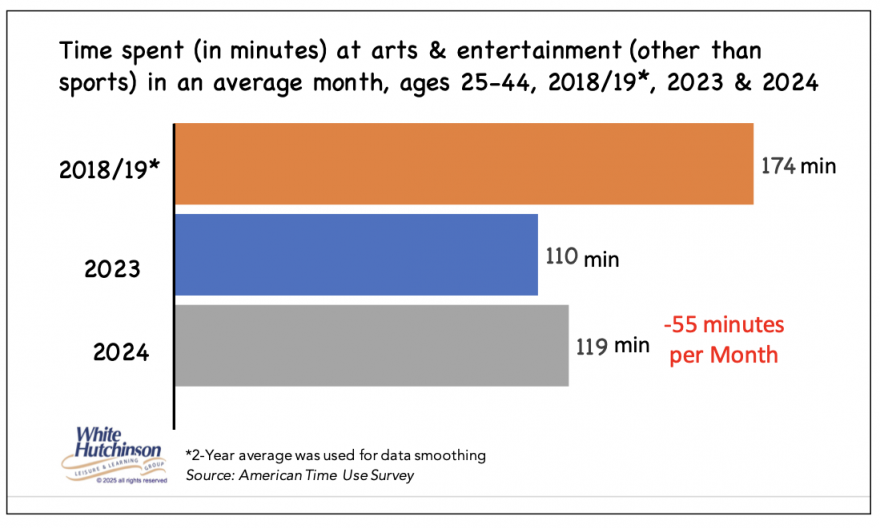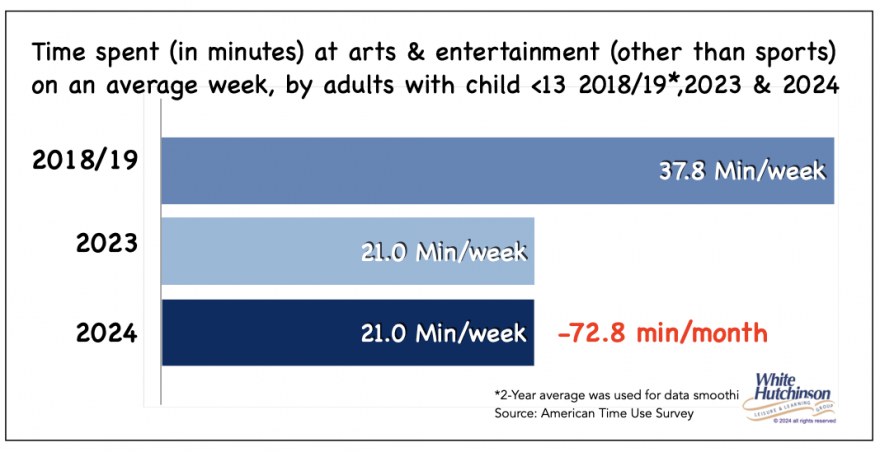
Vol. III, No. 8, August 2025
A fundamental shift in family time
There has been a noticeable shift in how American families with children experience and define "family time," especially for out-of-home leisure activities, including agritourism. The shift accelerated due to the pandemic.
Families are spending less time away from home. Compared to pre-pandemic 2019, Americans ages 15+ spent 34 minutes less a day away from home in 2024. When we focus on households with adults aged 25-44, the majority of families with children, there was a staggering decline of more than one hour per day (71 minutes) spent away from home between 2019 and 2024. This appears to be a permanent transformation rather than a temporary pandemic effect.

Some of that time away from home is spent attending entertainment and art venues, which include agritourism. For households with adults aged 25-44, there has been a decline in attendance time of nearly one-third, amounting to one hour per month (55 minutes) since 2019, the pre-pandemic year.

For all adults aged 18 and older with a child aged 12 or younger, there was an even greater decline in attendance time of 44%, amounting to more than one hour less per month since 2019 (-73 minutes).

The decline in time away from home has led to a retreat into the home, with significantly more time being spent on at-home family leisure activities than before the pandemic.
There has also been a transformation in how families define and experience "family time", especially for away-from-home leisure activities. The shift is two-fold:
- Parents are increasingly primarily pursuing their interests while bringing their children along rather than solely focusing on traditional kid-specific activities. Attendance at Dave & Buster's is one example. Although there are no children's games or other child-centric activities other than a children's menu option at the restaurant, approximately 30% of D&B's attendance is adults with children.
This trend of bringing children along is very noticeable at traditional adult destinations that are now becoming increasingly family-friendly. For example, many breweries and wineries are adapting to become the new go-to places for families. They're installing kid-friendly play areas, adding outdoor spaces for children to run around, and essentially creating hybrid environments that serve both adult and child needs simultaneously. This represents a fundamental shift from previous generations, where parents would either hire babysitters or simply forgo adult activities.
In just the opposite direction, some breweries and wineries are banning children to maintain an exclusive adult-only environment, especially for childless adults. - In addition to modern parents bringing their children along to adult-focused activities, some parents are also moving away from viewing adult and child activities as mutually exclusive, opting for more inclusive, shared hybrid experiences that both they and their children can enjoy together. The goal is less about entertaining children separately and more about building memories and strengthening family bonds through activities everyone can enjoy together.
Several practical factors contribute to these trends. Parents are seeking ways to socialize with other adults and get out of their small apartments while managing childcare costs. The expense of babysitters and the desire to maintain social connections have made bringing children to adult venues an economically attractive option.
This new family-friendly dynamic presents an interesting choice for agritourism venues. In 2023, 44% of households aged 25-44 had at least one child aged 12 or younger.
- Do you target those households who might want to bring their younger children along by including some child-friendly activities or hybrid activities that the parents and children can do together, while discouraging attendance by the 56% age 25-44 adult households without younger children who don't want to be around children
- Or do you maximize appeal to adult-only households by excluding any activities for children? Even then, as the Dave & Buster's example shows, many adults will still bring their children along for the ride.
- Or do you ban children, like many wineries and breweries do, or ban them after a particular evening hour, as some adult-oriented location-based entertainment venues do?
The best option depends on several factors, including the nature of the venue, its offerings, competition, and the demographics of the trade area.
Some agritourism venues pursue different options at different times, such as offering adult-focused events, including long-table dinners and various classes, and then at other times hosting family-friendly events, like the traditional fall festival with corn mazes and U-pick pumpkin patches.
Suppose an agritourism venue wants to simultaneously cater to both families with children and adults without children. In that case, the best option is to have separate zones for the different types of activities - create a highly-focused adult area, typically with alcohol options and food, make a zone with child-centric activities, and have an area with activities that parents and children can enjoy together.
Subscribe to Agritourism Today



